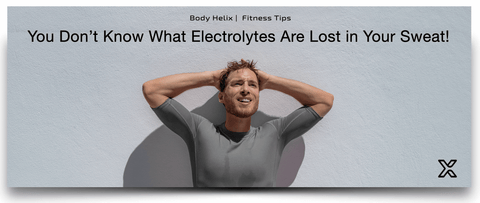You Don’t Know What Electrolytes Are Lost in Your Sweat! Draw From The Experience of Others.
I am not personally the biggest perspirer I know, but I sweat a lot when I play tennis. Have you noticed how Rafa Nadal is just drenched, but Carlos Alcaraz, or Roger Federer appear ready to party in the middle of a tennis match?
If you are not a tennis fan, pick your favorite sport and athlete, and you will notice a wide range of fluid and mineral loss. Everyone is different. And unless you are an elite athlete, you are much more likely to be like Rafa than Roger. But you may be an elite athlete and sweat like it's your job.
There has been significant research on fluid and electrolyte loss, and the results demonstrate just how difficult it is to determine the replacement needs of an individual athlete. As you will see, I will provide a gauge below that may help you make a reasonable calculation based on the many factors that affect how much you lose.

THE SWEAT FACTOR
Let's dispense with normal sweating as normal physiology of the human body. It is simply a mechanism by which heat is dissipated. The heat to be dissipated is generated by the work of contracting muscles, just as the radiator in your car helps dissipate the heat generated by the engine. Some disorders are marked by excess or deficient amounts of sweat, but we are only concerned with healthy sweating in this blog.
How can I say confidently that you do not know what replacement fluids and electrolytes would match your loss? You cannot know on any given day because many factors influence loss. The available studies will not have data on somebody who is your sweat doppelganger!
Among the factors that affect sweat volume and content are age, weight, temperature, and sport. Percent body fat is also a significant factor; fatty tissue is an excellent insulator, making heat dissipation much harder. The lean athlete with low percent body fat will dissipate heat more efficiently but be cold when the not-lean athlete is sweating at rest.
We know from scientific research on sweat that there is a wide range of sodium and potassium loss in sweat and, likewise, a wide range in the volume of sweat for which replacement drinks attempt to replenish. To estimate your calculations, you will want to pay attention to your body weight before and after exercise.
ESTIMATING YOUR FLUID LOSS
Ideally, you would urinate, weigh yourself nude before an exercise period and, as soon as possible, urinate, remove your exercise clothes, and then weigh yourself. Alternatively, weigh before and after exercise with your clothes on but weigh your clothes before and after so that you can determine how much fluid has been absorbed by your clothing.
Keep track of your fluid intake in milliliters or ounces during the exercise period. Recognizing that you have had no other losses during your exercise, the difference between the pre-and post-exercise weights reflects fluid loss. If you had an episode of vomiting or diarrhea during the exercise period, the weight change would reflect not only sweat fluid loss, but also total fluid loss.
Fluid loss = (pre-exercise weight – post-exercise weight) + (weight of sweaty clothes – weight of dry clothes)
For example, before exercise, an athlete weighs 150, and clothes weigh 2 pounds. After exercise, the athlete weighs 145, and the clothes weigh 5 pounds (reflecting sweat absorbed by clothes, socks, and shoes.) This athlete lost 8 pounds of fluid. Don't forget to urinate before the post-exercise weight since the fluid in the bladder is also lost during the exercise period.
Don't be surprised that you have lost several pounds (of fluid, not fat) while you exercise. In many endurance and explosive sports, fluid loss of 10 pounds is not uncommon among athletes who do not rehydrate ambitiously.
Significant fluid deficits of several liters can occur even in the athlete who attempts to rehydrate. The concern for the athlete with the fluid loss is related to a drop-off in performance that occurs with dehydration and electrolyte imbalance.
Recognizing that 2.2 pounds represent 1 liter of fluid, we can move to calculate how many liters of fluid you lost. In the example above, the athlete lost 8 pounds, equivalent to 3.6 liters. (8 lbs./2.2 pounds per liter) So now that you have some data on your weight change (same as fluid replacement needs), we can move on to making a rough estimate of your electrolyte replacement needs.
CALCULATING SODIUM AND POTASSIUM NEEDS
Because we will not measure your sweat's sodium and potassium content, we will want to use the information that scientists have gathered on athletes like us. And this is where the data becomes less and less precise in making our calculations.
We know the average healthy 20-year-old can lose 1,438 mg sodium and 216 mg potassium per liter of sweat with treadmill exercise. However, we don't have information on other age groups, so we will have to extrapolate.
Sodium loss is different depending on the sport. A wide range of sodium loss depending on the sport likely reflects the age of the athletes, temperature, conditioning, and intensity of the exercise.
Available data shows these losses, but they are reported as mg of sodium lost per hour, not per liter:
Football: 1510 mg/ hour
Endurance: 1280 mg/ hour
Basketball: 950 mg/ hour
Soccer: 940 mg/ hour
Baseball: 830 mg/ hour
So how do you calculate your sodium and potassium replacement needs? At best, we can only make an approximation by using the weight change reflecting fluid loss and selecting some empirical numbers for sodium and potassium loss.
Based on the range of sodium loss described above, I am taking the liberty of suggesting that sodium loss in sweat is in the range of 1,000-1,500 mg/liter and potassium is 200 mg/liter. These numbers may be wildly off for the elite athlete but will apply to the average athlete.
Let's apply these numbers to the example above and calculate the free water, sodium, and potassium deficits. We will assume initially that the athlete was not rehydrating and then do the calculation with the athlete hydrating.
Not hydrating: Weight loss of 8 pounds reflects a fluid loss of 3.6 liters (0.95 gallons), sodium and potassium deficit of 3.6 grams and 0.720 grams, respectively.
Hydrating (with HydroHelix) at 2 liters per hour: Weight loss would only be 3.6 pounds and a fluid loss of 1.6 liters (0.43 gallons), sodium and potassium deficit of 2.0 grams and 0.320 grams.
But remember, HydroHelix contains 800 mg and 200 mg of potassium, respectively, so there will still be a 400 mg deficit of sodium that was not matched by HydroHelix replacement. This will be added to the 2.0 gm deficit to reflect a more accurate deficit. The deficit, then, would be 2.4 grams of sodium.
REPLACEMENT + PERFORMANCE
Athletes who want to maximize their performance will want to pay attention to fluid and electrolyte replacement fundamentals, as described above. There is no doubt that performance can be degraded by mismanagement.
The description of fluid and electrolytes described here is a simplified summary. It is not an essay that would serve as preparation to take the American Board of Nephrology certifying exam, so if you find that my assumptions do not apply to you, make the necessary adjustments and recalculate.
The good news is that the human body is remarkably adept at adjusting to these metabolic challenges but correcting the deficits can take time. And if the correction takes too long, athletic performance can be impaired. The correct course of action is to do everything possible to keep hydrated and maintain electrolyte balance while exercising!
Tom Parker, MD
CEO, Body Helix
Whether an elite athlete or not, people trying to improve their healthspan understand that having a sport they love contributes to their overall wellness and happiness. One of the biggest reasons Body Helix continues to learn, share, and inspire is because of you. So many of our readers and customers overwhelmingly support our efforts and help us grow. The entire Body Helix team is extremely grateful to each of you. Please continue along this journey of discovery with us.




